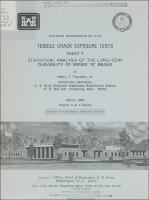Please use this identifier to cite or link to this item:
https://hdl.handle.net/11681/21413| Title: | Tensile crack exposure tests. Report 4, Statistical analysis of the long-term durability of series "B" beams |
| Authors: | Structures Laboratory (U.S.) United States. Army. Office of the Chief of Engineers Thornton, Henry T. |
| Keywords: | Concrete beams Concrete cracking Concrete exposure Free-thaw durability Nondestructive tests Reinforced concrete Resonant frequency Statistical analysis Ultrasonic pulse velocity tests Weathering (concrete) |
| Publisher: | U.S. Army Engineer Waterways Experiment Station. Engineer Research and Development Center (U.S.) |
| Description: | Technical memorandum Abstract: In November 1954, a long-term durability program was begun to determine the effects of severe natural weathering on reinforced concrete beams loaded to different stress levels and containing reinforcing steel with different types of bar deformations in either top-as-cast The beams were fabricated, cured, Waterways Experiment Station (WES) in or bottom-as-cast positions and loaded at the U. S. Army Engineer 1954, then shipped to Eastport, Maine, and placed on the beach at the natural weathering exposure station on the south side of Treat Island in Cobscook Bay. The beams were subjected to twice daily tidal cycles exposing them to wetting under considerable head and drying to surface dry conditions. In addition, during the winter months, the beams were subjected to cycles of freezing and thawing with each tide when the air temperature was at or below 28° F (-2.20 C). The beams were inspected annually during the exposure period and evaluated by a team of inspectors rating the degree of deterioration. Nondestructive tests were also performed. Each year data on condition, percent velocity squared (V2), and maximum crack width were collected. The data which were generated from this study were coded and entered onto the WES IBM 4331 computer for subsequent analyses using the Statistical Analysis System (SAS). An evaluation of the results of these analyses indicates that: a. Beams with steel in the bottom-as-cast position deteriorate at a slower rate than do beams with steel in the top-as-cast position for both A 305-50T and old-style deformation type, and beams with steel in the bottom-as-cast position exhibited smaller average maximum crack widths (significant at the 50,000- psi stress level). b. A 305-50T type reinforcement bar deformation exhibited less severe degradation trends than old-style, and A 305-50T deformation type exhibited a significantly larger percent V2 than did old-style deformation at the 50,000-psi stress level. c. As stress levels increased, the conditions of the beams generally decreased and the degradation of percent v2 increased. There were marked increase in maximum crack widths from the 40,000- to 50,000-psi stress levels for all positions and bar deformation types. d. The more severe exposure conditions of the zero stress (control) beams, i.e., partially covered with sand where a state of higher saturation was maintained, probably affected some anomalous results. Also, the early failure of some 50,000-psi stress level beams containing reinforcement bars with old-style deformations and the subsequent loss of incriminating performance data affected some anomalous results. |
| Rights: | Approved for public release; distribution is unlimited. |
| URI: | http://hdl.handle.net/11681/21413 |
| Appears in Collections: | Technical Memorandum |
Files in This Item:
| File | Description | Size | Format | |
|---|---|---|---|---|
| WES-Technical-Memorandum-No.6-412-Report-4.pdf | 2.55 MB | Adobe PDF |  View/Open |